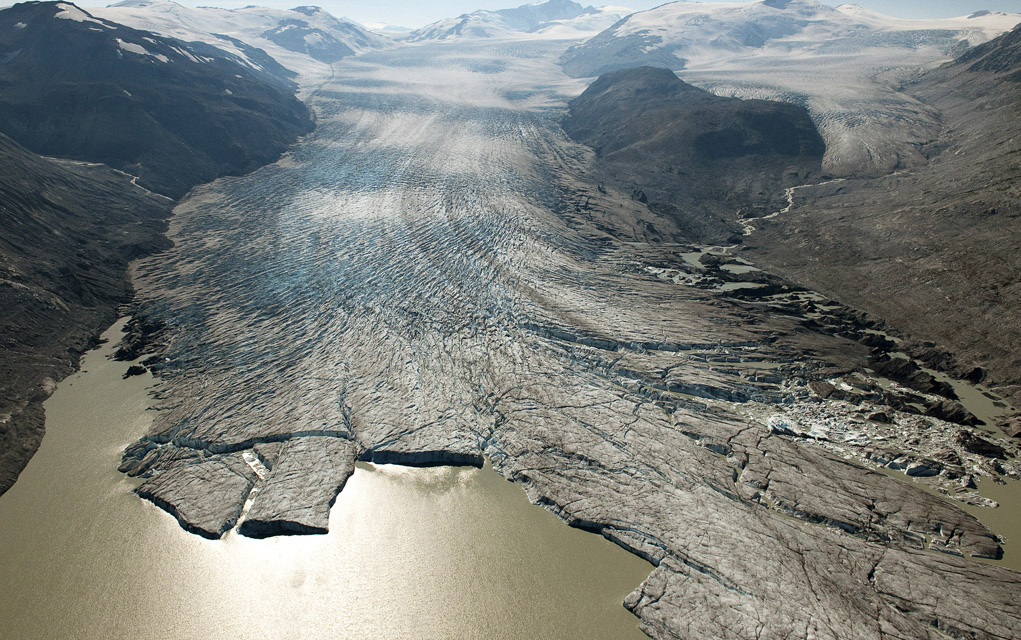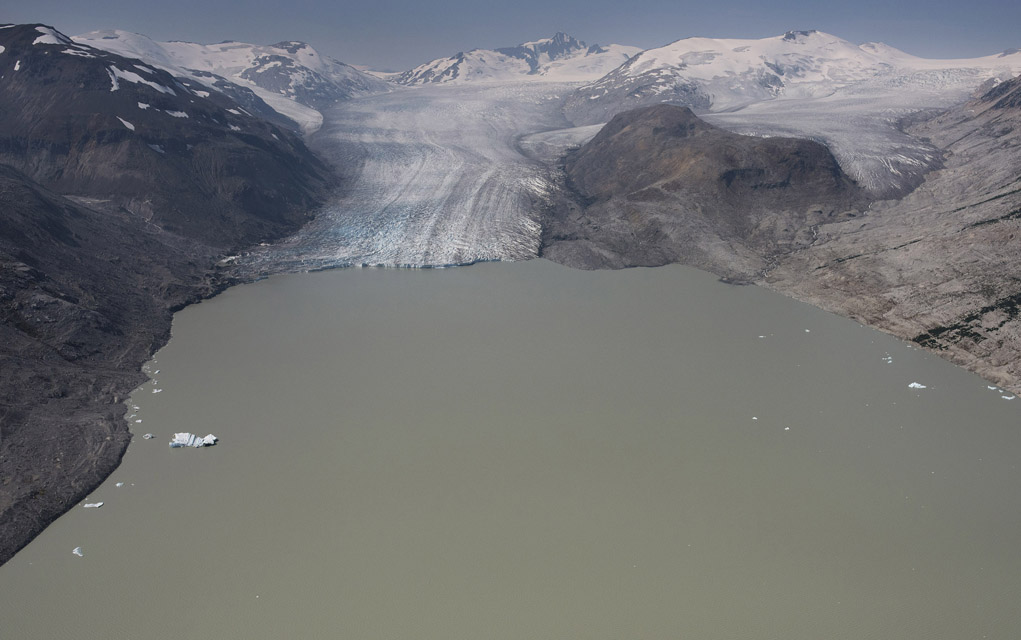
For almost 15 years, James Balog has dedicated his time to photographing glaciers. He’s chronicled major change — common occurrences like miles of retreating ice and height decreases equivalent to the Empire State Building. In that regard, his photos serve as a document for past, present and future.
“It’s about the past in that those glaciers are accumulative structures that come to us from the past,” he says. “It’s about the present in the sense of what the landscapes are doing on their own and what we’re doing to the landscapes right now. And it’s about the future, the future that will be affected by what’s expressed in those changes. The future also may not see a lot of these features.”
Now showing through Dec. 23 at the McNichols Civic Center Building in Denver Ice: Portraits of Vanishing Glaciers displays the photography of Balog from around the world. It also features work from Balog’s 2012 documentary Chasing Ice that follows him on his journey to capture these glaciers before they’re gone.
Balog always had an interest in science but not in being a scientist. He chose photography instead and became an environmental photographer in the early 1980s. He spent a large part of his career photographing wildlife, covering topics like endangered species and hunting.
He became increasingly aware of the reality of climate change through his work, and began to look for a story to tell. Ice made the perfect vehicle, but he ran into a problem.
“For the life of me I couldn’t figure out an interesting way of talking about ice,” he says. “It would turn into a really boring story about penguins and polar bears.”
He let the idea sit on the shelf for a few years until, in 2004, he was invited to shoot a story on climate change for The New Yorker. He flew to Iceland and quickly realized the country’s glaciers evocatively spoke to the decay caused by global warming.
Looking back on it now, Balog had no idea he’d still be photographing glaciers so many years later. At first, he says, he thought he would shoot the initial story. He then received another assignment for National Geographic. Then he decided to place a few time-lapse cameras on glaciers, then a few more.
“And at that point I thought it would be three summers and two winters, and that’s as far as I could imagine,” he says.
Part of the spark that ignited Balog’s passion was witnessing dramatic change so rapidly.
“I was so stunned by the speed of the change I was seeing,” he says. “I realized, ‘Boy, I have to get cameras out right now, as fast as possible, not miss a year and get going because this is huge.”
That happened between December of 2006 and March of 2007, which is when Balog officially started Extreme Ice Survey (EIS). Based in Boulder, EIS catalogs the effects of climate change on glacial ice by using video and photography, time-lapse and conventional. The Survey has multiple cameras located all over the world including Greenland, Iceland, Alaska and the Rocky Mountains. EIS is one of the most expansive studies of glaciers using ground-based, real-time photography.
In the past, he’s likened glacier photography to portraiture. He says he tries to evoke the individuality of the landscape, capturing character and personality.
Many of Balog’s photos are emotional. Watching these glaciers fade away is hard to stomach.
“It can be quite painful and haunting. At the same time, it can be quite beautiful and awe inspiring, because you realize you’re in the middle of history,” Balog says. “To see history unfolding in front of your eyes is a powerful thing. Most people go along in their normal time frame, in their ordinary human lives and they don’t think about their position in history. But watching this stuff happen, you definitely think about it.”
Since the beginning of his career in photography, Balog’s core theme has been to capture the collision between humans and nature.
“With a subject like this, that was one of my initial motivations, of this being perhaps one of the biggest collisions of our times,” he says. “I think it’s historic and important, and I’m trying to bring it to some creative light.”
Over the years, his goals for the project have remained the same: to celebrate the landscapes, to reveal change, and to communicate the meaning and importance of that change.


While his photos are beautiful, they serve a powerful purpose. They present irrefutable evidence that these glaciers are changing. His photoset from the Bridge Glacier in British Columbia captures the ice in 2009 and then in 2012, where the glacier retreats significantly and the lake at its base grows.
“I’m very conscious of the fact that the project is bringing evidence in comprehensible time. At times I’ve thought of this as almost like forensic evidence,” he says. “We’re going to a site and we’re collecting visual evidence that’s grounded in scientific knowledge of what happens and what it means. And we’re bringing that evidence back to the jury of the public and saying, ‘Here. It’s pretty obvious to me what’s happening, but you take a look.’”
Over the past decade, EIS and Balog’s work has helped to raise public awareness of the severity of climate change, but Balog wishes to see more political change to protect the environment. For now, he’ll continue to work.
“I was feeling much more hopeful a year ago,” he says. “I walk a razor’s edge now between hope and despair. I will myself to stay hopeful, but we have a disaster in the political leadership in Washington at a lot of different levels. I’m not sure what’s going to happen but what keeps me hopeful is there remains a lot of visionaries and creative imaginative people who are bending the arc of history. … All I can do is what I can do.”
Balog’s next project is a documentary called The Human Element, out next year. The film looks at how earth, air, fire and water are being changed by people and at the same time how people are being impacted by the changes they’ve contributed to in the natural environment.
On the Bill: ICE: Portraits of Vanishing Glaciers. Boettcher Cultural Pavilion, 2nd Floor, McNichols Civic Center Building, 144 W. Colfax Ave., Denver. Through Dec. 23.



